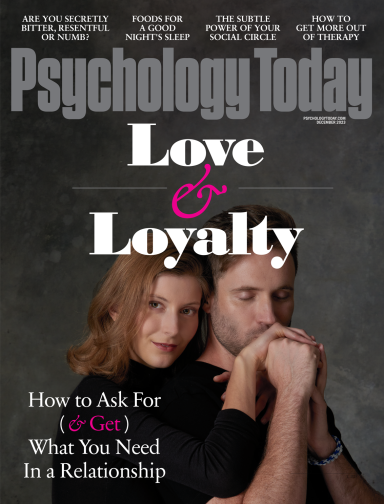Race and Ethnicity
Yellow Fever: The Exotification of Asian Women
Seeking Asian Female?
Posted April 2, 2013 Reviewed by Kaja Perina

April 2, 2013
Asian woman!
Did your head turn? Are you like Dug, the dog in “Up”, who can’t keep his focus after spotting a squirrel? Hmmm. You might be a fetishist. You might have Yellow Fever.
Filmmaker Debbie Lum describes a long history of being approached by white men with “yellow fever.” What, you might ask, is wrong with being attracted to certain "looks?" After all, some men are attracted to blondes, redheads or Swedes. And women have their preferences as well. But this particular brand of attraction leaves many Asian and Asian American women uncomfortable – and angry. The syndrome of Yellow Fever can range from mild preference to outright vulgarity, and is worthy of examination. (There is a related syndrome among gays and lesbians also known as “Rice Picking”.)
Most men with Yellow Fever know that they have Yellow Fever. They know they are more attracted to women of Asian ethnicity, but they are often unclear why. They might casually attribute it to looks, but when you probe more deeply, many can admit fascinations with Asian culture, or that they harbor stereotypes about Asian women, stereotypes which are blatantly racist, misogynist, and devaluing.
As this article by Goal Auzeen Saedi, Ph.D. points out, women of Asian ancestry are frequently exotified and stereotyped. They are “submissive, man-pleasing ‘sex kittens’”, or in a more palatable phrase I’ve heard “have great personalities.” What does that mean, exactly? Usually, it means that Asian women are perceived to be less aggressive, more docile and self-sacrificing – more obedient, in other words. They are perceived as less likely to challenge their partners and be compliant. (Saedi has another nice article on how exotification is a microaggression.)
Stereotypes are projections made in an attempt to organize the mind, exert power, and cope with and control a world that feels threatening or is not fully understood. They distort reality and create an environment of misunderstanding and even oppression. As Anais Nin wrote, “we see the world not as it is, but as we are.” Any person projecting the stereotypes of submissiveness, etc. onto an Asian female is likely to get a sound rebuke. Racist and polarizing assumptions limit possibilities and invite backlash. Why would the person with Yellow Fever need to project limiting stereotypes onto their partner? First, the stereotype becomes the object of desire. Why is that? Everyone’s different, but suspects include a consuming need for control, an inability to integrate one’s own feminine capacity, an immature or wounded masculinity, and outright racist attitudes and even a thirst for exploitation of “the other.” Stereotypes are held steadfastly in ignorance of reality, and the worst culprits manifest in creepiness, perversion and sociopathy.
Debbie Lum’s award-winning film “Seeking Asian Female” will air on PBS’s Independent Lens on May 6th. She is ramping up to that debut with a series of webisodes exploring the issues involved in interracial relationship and attraction. I sat down with Debbie during the recent 2013 CAAMFest (formerly known as the San Francisco International Asian American Film Festival), where she won the Jury Prize for Best Documentary Feature. That interview is here:
Lum interviewed many white men who professed a preference for Asian women. She ended up following a man with a relatively extreme case of Asiaphilia for five years. He used international dating sites to meet and finally get engaged to a much younger Chinese woman from Anhui province in China. This raises issues of race, class, power differences across two very different cultures, and might at worse be seen as lying on the spectrum of sex trafficking. (Steve says jocularly and without inhibition “I’m losing weight from all the sex and the vegetables (she’s making).”
The director, trying to maintain distance and neutrality behind the camera, is drawn into the relationship as a translator (Steve doesn’t speak Chinese, and Sandy doesn’t speak English). It is a very personal movie, for all parties involved; Lum ends up having a journey during the film as well, as she moves from her preconceived notions based on years of being targeted by “Yellow Fever”, to an acceptance of this particular relationship, with all its nuances. “I ended up with a much more human story of two people relating to each other,” rather than a portrayal of right or wrong. “All of the ways I had thought about the issue had to be thought about differently after having filmed their story.”
Still, “We don’t like it when there are men out there objectifying us. (But) when you get older, you realize people make a lot of mistakes in making a relationship,” including making projections that don’t match with reality or don’t allow the person to be who they really are.
The problem is that these relationship “choices” are being made in a context that usually places White men at the top and Asian men at the bottom of a scale of manhood. Some scholars speak of a ‘hiergamy’ or hierarchy of manhood that is tied to race and power in society. Thus white men generally have more choice and say in asserting their desires, and are often seen as more desirable by potential partners by virtue of their status in society. And women have power to choose as well, and are essentially the gatekeepers to relationship. When either men or women choose to marry into the dominant culture, this can naturally raise questions of connection with versus devaluing of their own ethnicity, questions that must be dealt with actively. Underscoring this point is the fact that Japanese Americans have the highest outmarriage rate of any Asian ethnicity – this is attributed to factors including that they have a long history in the United States, and the effects of Internment during World War II, leading to internalized shame and a wish to assimilate and not stand out. This is not to say that interracial relationships are “wrong” in any way – it’s just that they occur in a context. But ultimately, making any relationship work – is work. My hat is off to any couple, straight or gay of any race, that can make theirs work.
Most Asian and Asian American men and women do choose to marry each other – but the Asian-White pairing tends to be an area of scrutiny, because of the underlying issues of racism and power differential. Asian American men often feel like they have been emasculated by popular culture, while Asian American women are portrayed as desirable, exotic beauties who will cater to their man’s every whim.
Some may feel that “love” is above politics – but sexual politics that involve race, sexism, class, religion, and so on are powerful forces. We become ourselves through relatedness. Relationship can be a lens and mirror to explore those forces, and desire itself. Sometimes it is a refuge against all those forces. We become better people in relatedness. When we allow other people to be who they are, and not who we want them to be, we take a step towards true freedom, and the highest form of love.
© 2013 Ravi Chandra, M.D. All rights reserved.




